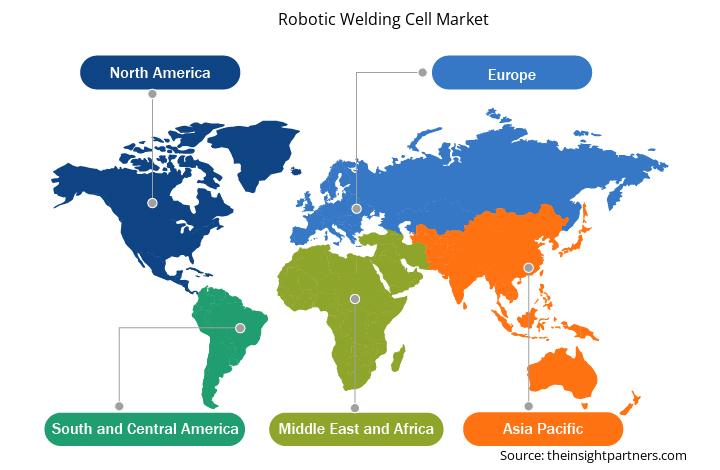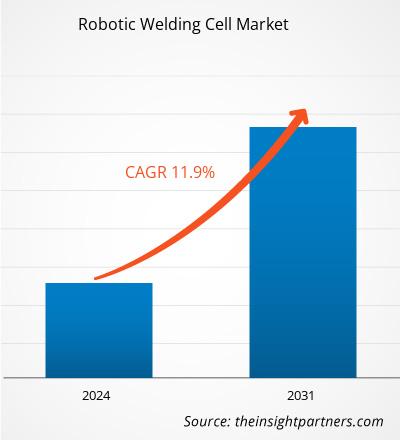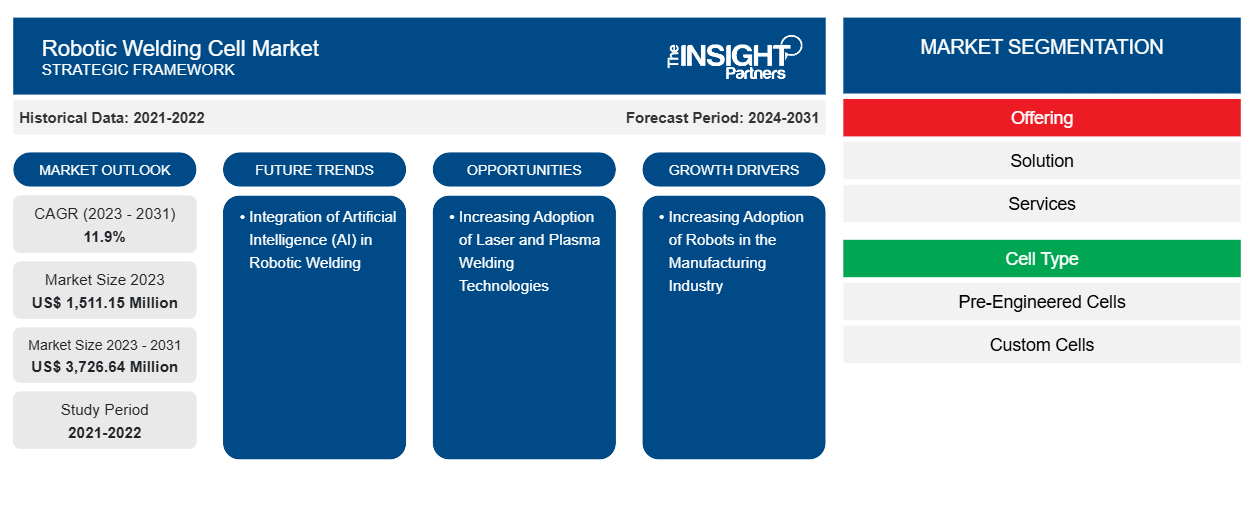로봇 용접 셀 시장 규모는 2023년 1,511.15백만 달러에서 2031년까지 3,726.64백만 달러로 성장할 것으로 예상됩니다. 이 시장은 2023~2031년 동안 11.9%의 CAGR을 기록할 것으로 예상됩니다. Industry 4.0 기술의 채택 증가는 향후 몇 년 동안 시장에 새로운 주요 트렌드를 가져올 가능성이 높습니다.
로봇 용접 셀 시장 분석
로봇 용접 셀은 부품을 용접하기 위해 함께 작동하는 여러 구성 요소로 구성됩니다. 로봇 용접 셀은 세계적 수준의 용접 작업을 제공하며 운영자 비용과 시간을 절약하기 위해 글로벌 표준에 따라 설계되었습니다. 사전 설계된 셀은 비용 효율적인 로봇 용접 셀이며 용접 프로세스에 필요한 기본적인 필수 구성 요소만 포함합니다. 셀의 이러한 기본 구조는 빠르게 설치할 수 있으며 제조업체는 셀 생산 시간을 줄이고 최종 제품을 최대한 빨리 제공할 수 있습니다. 맞춤형 셀은 기본 필수 구성 요소와 함께 고유한 장비를 포함하기 때문에 사전 설계된 셀에 비해 비쌉니다. 이는 주로 고객의 특정 관심사에 따라 제조됩니다. 따라서 맞춤형 로봇 용접 셀을 제조하고 제공하는 데 필요한 시간은 사전 설계된 셀보다 더 깁니다. 용접 로봇은 자동차 산업에서 널리 사용됩니다. 차량에 대한 수요가 눈에 띄게 증가하고 있습니다. 증가하는 소비자 지출은 전 세계, 특히 아시아 국가에서 차량 수요를 견인하는 요인 중 하나입니다. 국제자동차제조업자기구(IOM)가 2024년에 발표한 자료에 따르면, 2023년 전체 자동차 생산량은 9,300만 대에 달해 2021년 대비 2023년 대비 12% 증가했습니다. 신규 시설 건설이 늘어나면서 이러한 신규 자동차 시설에서 용접 로봇에 대한 수요가 증가했고, 궁극적으로 로봇 용접 셀 시장이 성장했습니다.
로봇 용접 셀 시장 개요
글로벌 로봇 용접 셀 시장 생태계 의 주요 이해 관계자 로는 원자재/구성 요소 공급업체, 로봇 용접 셀 제조업체, 정부 기관, 규제 기관 및 최종 고객이 있습니다. 구성 요소 및 하드웨어 공급업체는 로봇 용접 셀 제조업체에 다양한 구성 요소와 부품을 제공합니다. 이 보고서에 포함된 주요 로봇 용접 셀 제조업체로는 Abb Ltd, Acieta LLC, Carl Cloos Schweisstechnik Gmbh, Kawasaki Heavy Industries, Ltd; Kuka AG; Phoenix Industrial Solutions; The Lincoln Electric Company; Wec Group Ltd.; 및 Yaskawa America, Inc. 등이 있습니다. 로봇 용접 셀 제조업체에 이어 글로벌 로봇 용접 셀 시장에는 여러 주변 이해 관계자가 있으며, 이들은 로봇 용접 셀의 기술적 발전과 채택을 가능하게 하는 데 중요한 역할을 합니다.
귀하의 요구 사항에 맞게 이 보고서를 사용자 정의하세요
이 보고서의 일부 또는 국가 수준 분석, Excel 데이터 팩을 포함하여 모든 보고서에 대한 사용자 정의를 무료로 받을 수 있으며 신생 기업 및 대학을 위한 훌륭한 혜택과 할인 혜택을 이용할 수 있습니다.
- 이 보고서의 주요 시장 동향을 알아보세요.이 무료 샘플에는 시장 동향부터 추정 및 예측까지 다양한 데이터 분석이 포함됩니다.
로봇 용접 셀 시장 동인 및 기회
제조업계에서 로봇 도입 증가
로봇은 제조 산업에서 중요한 역할을 합니다. 로봇은 생산 작업에서 전반적인 효율성과 생산성을 높이는 데 도움이 됩니다. 조립 및 분배, 취급 및 피킹, 가공 및 절단, 용접 및 납땜, 주조 및 성형, 마무리 및 샌딩, 페인팅 및 코팅, 세척 및 위생, 물류 및 보관, 포장 및 팔레타이징과 같은 다양한 응용 분야에서 제조 산업에서 사용되고 있습니다. 2024년 국제 로봇 연맹에서 발표한 데이터에 따르면 2023년 전 세계 공장에서 약 420만 대의 로봇이 운영되고 있었으며, 이는 2022년의 390만 대에서 증가한 수치입니다. 2021년 국제 로봇 연맹에서 밝힌 바와 같이 공장에서 작동하는 총 로봇의 절반은 용접 응용 분야에 사용될 것입니다. 따라서 제조 산업에서 로봇 채택이 증가함에 따라 로봇 용접 셀 시장 성장이 촉진되고 있습니다.
레이저 및 플라즈마 용접 기술 채택 증가
레이저 용접에 대한 수요가 빠르게 증가하고 있습니다. 레이저 용접 기술은 이산화탄소, 질소, 헬륨을 사용하여 개발된 고에너지 레이저 빔을 사용합니다. 이는 높은 정밀도와 속도로 재료를 접합하는 데 도움이 됩니다. 레이저 용접의 인기는 왜곡이 최소화되고 다양한 재료를 용접할 수 있는 능력으로 인해 증가하고 있습니다. 또한 레이저 효율성을 개선하고 용접 공정을 최적화함으로써 이러한 유형의 용접 기술로 전반적인 에너지 절약을 달성할 수 있습니다. 이는 레이저 용접에 대한 수요를 증가시키는 중요한 요인 중 하나이며, 에너지 소비를 줄이는 것이 전 세계적으로 주요 관심사 중 하나이기 때문입니다.
또한, AI 및 ML과 같은 첨단 기술과 통합되면 이 용접 기술은 효율적으로 수행할 수 있습니다. 따라서 레이저 용접 기술에 대한 수요가 눈에 띄게 증가하고 있습니다. 마찬가지로 플라즈마 용접 기술은 높은 전력 밀도, 깨끗하고 매끄러운 용접, 높은 용접 속도, 낮은 왜곡 및 개선된 갭 브리징을 포함한 다양한 이점을 제공합니다. 플라즈마 용접을 통해 생성된 용접은 매우 강하고 눈에 띄지 않습니다.
로봇 용접 셀 시장 보고서 세분화 분석
로봇 용접 셀 시장 분석에 기여한 주요 세그먼트는 제공 품목, 셀 유형, 최종 사용 산업입니다.
- 제공에 따라 글로벌 로봇 용접 셀 시장은 솔루션과 서비스로 나뉩니다. 솔루션 세그먼트는 2023년에 더 큰 시장 점유율을 차지했으며 예측 기간 동안 더 높은 CAGR을 기록할 것으로 예상됩니다. 로봇 용접 셀 솔루션은 제조업체가 추가 생산 용량을 달성하고 노동력 부족 문제를 완화하는 데 도움이 됩니다. 수동 용접 프로세스에 비해 로봇 용접 셀의 이러한 이점은 로봇 용접 셀에 대한 수요를 촉진하고 있습니다.
- 셀 유형에 따라 글로벌 로봇 용접 셀 시장은 사전 설계된 셀과 맞춤형 셀로 구분됩니다. 사전 설계된 셀 세그먼트는 2023년 68.3%의 시장 점유율로 셀 유형 세그먼트를 지배했으며 맞춤형 셀 세그먼트는 예측 기간 동안 더 높은 CAGR을 기록할 것으로 추정됩니다. 사전 설계된 로봇 용접 셀은 더 긴 로봇 조작기와 두 개의 더 큰 탁상이 있는 더 큰 작업 공간을 갖춘 표준 로봇 용접 셀입니다. 반면 맞춤형 셀은 최종 사용자의 요구 사항에 따라 제조되며 특정 산업에 맞게 맞춤화됩니다.
- 최종 사용 산업을 기준으로 글로벌 로봇 용접 셀 시장은 자동차, 제조, 항공우주 및 방위로 세분화됩니다. 자동차 부문은 시장에서 두 번째로 큰 점유율을 차지했으며 예측 기간 동안 가장 높은 성장률을 기록할 것으로 예상됩니다. 자동차 산업의 수요를 견인하는 요인 중 하나는 전 세계적으로 자동차의 생산 및 판매가 증가하고 있다는 것입니다. 제조 산업은 예측 기간 동안 주목할 만한 CAGR을 기록할 것으로 예상됩니다. 제조 부문에서 로봇 용접 셀에 대한 수요를 견인하는 요인 중 하나는 전 세계적으로, 특히 개발도상국에서 산업화 추세가 증가하고 있다는 것입니다.
로봇 용접 셀 시장 점유율 분석
로봇 용접 셀 시장 보고서의 지리적 범위는 자세한 지역 및 국가 분석을 제공합니다. 북미, 유럽 및 아시아 태평양은 로봇 용접 셀 시장에서 상당한 성장을 목격하는 주요 지역입니다. 중국은 2022년 로봇 설치 총 수에서 시장 점유율의 약 60%를 차지했습니다. 중국은 2022년에 ~0.2백만 대의 로봇을 설치한 반면 일본은 2022년에 50,000대 이상을 설치하여 전 세계에서 두 번째로 큰 시장이 되었습니다. 중국과 일본 외에도 싱가포르, 인도 및 태국은 아시아 태평양의 주요 시장 중 일부입니다.
유럽은 산업용 로봇 설비와 로봇 용접 셀 산업에서 두 번째로 큰 시장 점유율을 차지했습니다. 독일은 2023년 유럽에서 로봇 용접 셀과 산업용 로봇의 가장 큰 시장이었습니다. 로봇 용접 셀에 대한 수요를 견인하는 요인 중 하나는 독일에서 Industry 4.0 기술 채택을 늘리는 데 중점을 두고 있다는 것입니다. 독일, 프랑스, 영국, 이탈리아는 로봇 용접 셀 시장에서 주목할 만한 점유율을 차지하고 있습니다.
북미는 산업 전반에 걸쳐 몇몇 주요 제조 회사가 존재하고, Industry 4.0에 대한 필요성이 증가하고, 첨단 기술에 대한 수요가 증가함에 따라 로봇 용접 셀의 주목할 만한 시장 중 하나입니다. 미국은 국가의 산업화 및 디지털화 추세로 인해 시장에서 가장 큰 점유율을 차지했습니다. 또한 미국에는 Tesla, Boeing, Ford Motors와 같은 몇몇 주요 자동차 및 항공우주 제조 회사가 있습니다.
로봇 용접 셀 시장 지역 통찰력
Insight Partners의 분석가들은 예측 기간 동안 로봇 용접 셀 시장에 영향을 미치는 지역적 추세와 요인을 철저히 설명했습니다. 이 섹션에서는 북미, 유럽, 아시아 태평양, 중동 및 아프리카, 남미 및 중미의 로봇 용접 셀 시장 세그먼트와 지리에 대해서도 설명합니다.

- 로봇 용접 셀 시장에 대한 지역별 데이터 얻기
로봇 용접 셀 시장 보고서 범위
| 보고서 속성 | 세부 |
|---|---|
| 2023년 시장 규모 | 1,511.15백만 달러 |
| 2031년까지 시장 규모 | 3,726.64백만 달러 |
| 글로벌 CAGR (2023-2031) | 11.9% |
| 역사적 데이터 | 2021-2022 |
| 예측 기간 | 2024-2031 |
| 다루는 세그먼트 | 제공함으로써
|
| 포함된 지역 및 국가 | 북아메리카
|
| 시장 선도 기업 및 주요 회사 프로필 |
|
로봇 용접 셀 시장 플레이어 밀도: 비즈니스 역학에 미치는 영향 이해
로봇 용접 셀 시장은 소비자 선호도의 변화, 기술 발전, 제품의 이점에 대한 인식 증가와 같은 요인으로 인해 최종 사용자 수요가 증가함에 따라 빠르게 성장하고 있습니다. 수요가 증가함에 따라 기업은 제품을 확장하고, 소비자의 요구를 충족하기 위해 혁신하고, 새로운 트렌드를 활용하여 시장 성장을 더욱 촉진하고 있습니다.
시장 참여자 밀도는 특정 시장이나 산업 내에서 운영되는 회사나 기업의 분포를 말합니다. 주어진 시장 공간에 얼마나 많은 경쟁자(시장 참여자)가 존재하는지 그 규모나 전체 시장 가치에 비해 나타냅니다.
로봇 용접 셀 시장에서 운영되는 주요 회사는 다음과 같습니다.
- ABB 유한회사
- 아치에타
- Carl Cloos Schweisstechnik GmbH
- 링컨 일렉트릭 홀딩스 주식회사
- 쿠카 AG
- 가와사키 중공업 주식회사
면책 조항 : 위에 나열된 회사는 어떤 특별한 순서에 따라 순위가 매겨지지 않았습니다.

- 로봇 용접 셀 시장 주요 주요 업체 개요를 알아보세요
로봇 용접 셀 시장 뉴스 및 최근 개발
로봇 용접 셀 시장은 1차 및 2차 연구 이후의 정성적, 정량적 데이터를 수집하여 평가합니다. 여기에는 중요한 기업 간행물, 협회 데이터 및 데이터베이스가 포함됩니다. 로봇 용접 셀 시장의 몇 가지 개발 사항은 다음과 같습니다.
- ABB의 새로운 OmniVance FlexArc Compact 셀은 공간을 절약하고 용접 애플리케이션에 유연성을 더합니다. ABB Ltd.는 더 큰 유연성, 사용 편의성 및 더 나은 통합을 갖춘 새로운 소형 용접 애플리케이션 셀인 OmniVance FlexArc Compact를 출시하여 기업이 용접 인력 부족 문제를 해결하는 데 도움을 줍니다. OmniVance FlexArc Compact는 동급에서 가장 작은 아크 용접 셀입니다. 혁신적인 45도 갠트리 로봇 마운트 설계는 로봇을 3축 턴테이블의 중앙에 배치하여 작업물에 더 가깝게 배치하여 로봇의 작업 매개변수를 극대화합니다. (ABB Ltd., 회사 웹사이트, 2022년 6월)
로봇 용접 셀 시장 보고서 범위 및 제공물
"로봇 용접 셀 시장 규모 및 예측(2021-2031)" 보고서는 아래 영역을 포괄하는 시장에 대한 자세한 분석을 제공합니다.
- 범위에 포함된 모든 주요 시장 세그먼트에 대한 국가 수준의 로봇 용접 셀 시장 규모 및 예측
- 로봇 용접 셀 시장 동향 및 드라이버, 제약 및 주요 기회와 같은 시장 역학
- 자세한 PEST 및 SWOT 분석
- 주요 시장 동향, 국가 프레임워크, 주요 업체, 규정 및 최근 시장 개발 사항을 포괄하는 로봇 용접 셀 시장 분석
- 시장 집중도, 히트맵 분석, 유명 업체 및 로봇 용접 셀 시장의 최근 개발 사항을 포함하는 산업 환경 및 경쟁 분석
- 자세한 회사 프로필
- 과거 분석(2년), 기준 연도, CAGR을 포함한 예측(7년)
- PEST 및 SWOT 분석
- 시장 규모 가치/거래량 - 글로벌, 지역, 국가
- 산업 및 경쟁 환경
- Excel 데이터세트
최근 보고서
관련 보고서
사용 후기
구매 이유
- 정보에 기반한 의사 결정
- 시장 역학 이해
- 경쟁 분석
- 고객 인사이트
- 시장 예측
- 위험 완화
- 전략 기획
- 투자 타당성 분석
- 신흥 시장 파악
- 마케팅 전략 강화
- 운영 효율성 향상
- 규제 동향에 발맞춰 대응





















 무료 샘플 받기 - 로봇 용접 셀 시장
무료 샘플 받기 - 로봇 용접 셀 시장